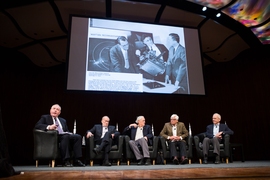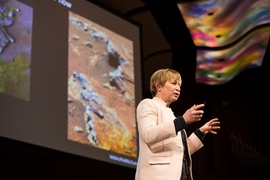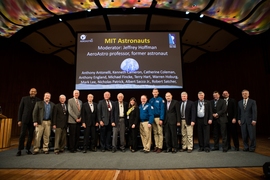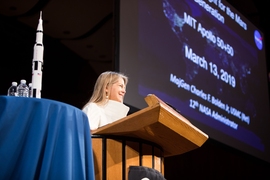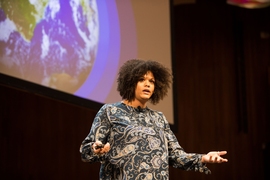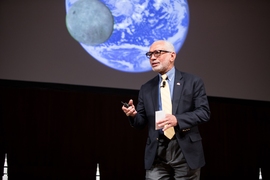On Sept. 12, 1962, in a speech given in Houston to pump up support for NASA’s Apollo program, President John F. Kennedy shook a stadium crowd with the now-famous quote: “We choose to go to the moon in this decade and do the other things, not because they are easy, but because they are hard.”
As he delivered these lines, engineers in MIT’s Instrumentation Laboratory were already taking up the president’s challenge. One year earlier, NASA had awarded MIT the first major contract of the Apollo program, charging the Instrumentation Lab with developing the spacecraft’s guidance, navigation, and control systems that would shepherd astronauts Michael Collins, Buzz Aldrin, and Neil Armstrong to the moon and back.
On July 20, 1969, the hard work of thousands paid off, as Apollo 11 touched down on the lunar surface, safely delivering Armstrong and Aldrin ScD ’63 as the first people to land on the moon.
On Wednesday, MIT’s Department of Aeronautics and Astronautics (AeroAstro) celebrated the 50th anniversary of this historic event with the daylong symposium “Apollo 50+50,” featuring former astronauts, engineers, and NASA adminstrators who examined the legacy of the Apollo program, and MIT faculty, students, industry leaders, and alumni who envisioned what human space exploration might look like in the next 50 years.
In welcoming a large audience to Kresge Auditorium, some of whom sported NASA regalia for the occasion, Daniel Hastings, head of AeroAstro, said of today’s prospects for space exploration: “It’s the most exciting time since Armstrong and Aldrin landed on the moon.”
The event kicked off three days of programming for MIT Space Week, which also included the Media Lab’s “Beyond the Cradle: Envisioning a New Space Age” on March 14, and the student-led “New Space Age Conference” on March 15.
“We could press on”
As a “baby boomer living through Apollo,” retired astronaut Charles Bolden, NASA’s 12th administrator, said the Apollo program illustrated “how masterful we were at overcoming adversity.” In a keynote address that opened the day’s events, Bolden reminded the audience that, at the time the ambitious program got underway in the 1960s, the country was in the violent thick of the civil rights movement.
“We were killing each other in the streets,” Bolden said. “And yet we had an agency like NASA, and a small group of people, who were able to bear through everything and land on the moon. … We could recognize there were greater things we could do as a people, and we could press on.”
For MIT’s part, the push began with a telegram on Aug. 9, 1961, to Charles Stark Draper, director of the Instrumentation Laboratory, notifying him that NASA had selected the MIT lab “to develop the guidance navigation system of the Project Apollo spacecraft.” Draper, who was known widely as “Doc,” famously assured NASA of MIT’s work by volunteering himself as a crew member on the mission, writing to the agency that “if I am willing to hang my life on our equipment, the whole project will surely have the strongest possible motivation.”
This of course proved unnecessary, and Draper went on to lead the development of the guidance system with “unbounded optimism,” as his former student and colleague Lawrence Young, the MIT Apollo Program Professor, recalled in his remarks.
“We owe the lighting of our fuse to Doc Draper,” Young said.
At the time that MIT took on the Apollo project, the Instrumentation Laboratory, later renamed Draper Laboratory, took up a significant footprint, with 2,000 people and 15 buildings on campus, dedicated largely to the lunar effort.
“The Instrumentation Lab dwarfed the [AeroAstro] department,” said Hastings, joking, “it was more like the department was a small pimple on the Instrumentation Lab.”
Apollo remembered
In a highlight of the day’s events, NASA astronauts Walter Cunningham (Apollo 7) and Charles Duke SM ’64 (Apollo 16), and MIT Instrumentation Laboratory engineers Donald Eyles and William Widnall ’59, SM ’62 — all from the Apollo era — took the stage to reminisce about some of the technical challenges and emotional moments that defined the program.
One of the recurring themes of their conversation was the observation that things simply got done faster back then. For instance, Duke remarked that it took just 8.5 years from when Kennedy first called for the mission, to when Armstrong’s boots hit the lunar surface.
“I would argue the proposal for such a mission would take longer [today],” Duke said to an appreciative rumble from the audience.
The Apollo Guidance Computer, developed at MIT, weighed 70 pounds, consumed 55 watts of power — half the wattage of a regular lightbulb — and took up less than 1 cubic foot inside the spacecraft. The system was one of the first digital flight computers, and one of the first computers to use integrated circuits.
Eyles and Widnall recalled in detail the technical efforts that went into developing the computer’s hardware and software. “If you’re picturing [the computer code] on a monitor, you’d be wrong,” Eyles told the audience. “We were writing the program on IBM punch cards. That clunking mechanical sound of the key-punch machine was the soundtrack to creating the software.”
Written out, that code famously amounted to a stack of paper as tall as lead software engineer Margaret Hamilton — who was not able to participate in Wednesday’s panel but attended the symposium dinner that evening.
In the end, the Apollo Guidance Computer succeeded in steering 15 space flights, including nine to the moon, and six lunar landings. That’s not to say that the system didn’t experience some drama along the way, and Duke, who was the capsule communicator, or CAPCOM, for Apollo 11, remembers having to radio up to the spacecraft during the now-famous rocky landing.
“When I heard the first alarm go off during the braking phase, I thought we were dead in the water,” Duke said of the first in a series of alerts that the Apollo astronauts reported, indicating that the computer was overloaded, during the most computationally taxing phase of the mission. The spacecraft was several miles off course and needed to fly over a “boulder field,” to land within 60 seconds or risk running out of fuel.
Flight controllers in Houston’s Mission Control Center determined that if nothing else went wrong, the astronats, despite the alarms, could proceed with landing.
“Tension was high,” Duke said of the moment. “You didn’t want to touch down on a boulder and blow a nozzle, and spoil your whole day.”
When the crew finally touched down on the Sea of Tranquility, with Armstrong’s cool report that “the Eagle has landed,” Duke, too wound-up to properly verbalize the callback “Tranquility,” recalls “I was so excited … it came out as ‘Twang,’ or something like that.’ The tension — it was like popping a balloon.”
Since the Apollo era, NASA has launched astronauts on numerous missions, many of whom are MIT graduates. On Wednesday, 13 of those graduates came onstage to be recognized along with the Apollo crew.
In introducing them to the audience, Jeffrey Hoffman, a former astronaut and now AeroAstro professor of the practice, noted MIT’s significant representation in the astronaut community. For instance, in the five missions to repair the Hubble Space Telescope, which comprised 24 spacewalks, 13 of those were performed by MIT graduates.
“That’s pretty cool,” Hoffman said.
On the horizon
The Apollo moon rocks that were were brought back to Earth have “evolved our understanding of how the moon formed,” said Maria Zuber, MIT’s vice president for research and the E.A. Griswold Professor of Geophysics in the Department of Earth, Atmospheric and Planetary Sciences. These rocks “vanquished” the idea that the moon originally formed as a cold assemblage of rocks and “foo foo dust,” she said.
Instead, after carefully analyzing samples from Apollo 11 and other missions, scientists at MIT and elsewhere have found that the moon was a dynamic body, with a surface that at one time was entirely molten, and a metallic core, or “dynamo,” powering an early, lunar magnetic field. Even more provocative was the finding that the moon was not in fact “bone-dry,” but actually harbored water — an idea that Zuber said was virtually unpublishable until an MIT graduate reported evidence of water in Apollo samples, after which the floodgates opened in support of the idea.
To consider the next 50 years of space exploration, the MIT symposium featured a panel of faculty members — Paulo Lozano, Danielle Wood, Richard Binzel, and Sara Seager — who highlighted, respectively, the development of tiny thrusters to power miniature spacecraft; an effort to enable wider access to microgravity missions; an MIT student-designed mission (REXIS) that is currently analyzing the near-Earth asteroid Bennu; and TESS and ASTERIA, satellite missions that are currently in orbit, looking for planets and possibly, life, outside our solar system.
Industry leaders also weighed in on the growing commercialization of space exploration, in a panel, moderated by Olivier de Weck, Professor of Aeronautics and Astronautics and Engineering Systems, featuring MIT alums who currently head major aerospace companies.
Keoki Jackson, chief technology officer of Lockheed Martin, noted the pervasiveness of space-based technologies, such as GPS-dependent apps for everything from weather and news, to Uber.
“[Commercial enterprises] have made space a taken-for-granted part of life,” said Jackson, noting later in the panel that in 2015, 1 billion GPS devices had been sold around the world. “This shows you what can happen exponentially when you come up with something truly enabling.”
“The challenge we face is talent, and in particular, diversity,” said John Langford, CEO and founder of Aurora Flight Sciences, who noted the panel’s all-male participants as an example. “It’s an industry-wide challenge. We’re working to reform ourselves, as we move from the brigade-type technologies that we grew up with, to incorporating technologies such as computer technology and artificial intelligence.”
Future missions
In a glimpse of what the future of space exploration might hold, MIT students presented lightning talks on a range of projects, including a custom-designed drill to excavate ice on Mars, a system that makes oxygen on Mars to fuel return missions to Earth, and a plan to send CubeSats around the world to monitor water vapor as a measure of climate change.
Audience members voted online for the best pitch, which ultimately went to Raichelle Aniceto and her presentation of a CubeSat-enabled laser communications system designed to transmit large amounts of data from the moon to Earth in just five minutes.
In the last keynote address of the symposium, Thomas Zurbuchen, associate administrator for NASA’s Science Mission Directorate, told the audience that there is still a lot of research to be done on the moon, which he said is changing, as evidenced by new craters that have formed in the last 50 years.
“The moon of the Apollo era is not the same moon of today,” said Zurbuchen, who noted that just this week, NASA announced it will open previously unlocked samples of soil collected by the Apollo missions.
In closing the symposium, Dava Newman, the Apollo Program Professor of Astronautics and former NASA deputy administrator, envisioned a future dedicated to sending humans back to the moon, and ultimately to Mars.
“I’m a rocket scientist. I got here because of Apollo, and Eleanor Roosevelt said it best: Believe in the beauty of your dreams,” Newman said. “The challenge is, within 50 years, to be boots on Mars. I think we have the brains and the doers and inspiration to really make that happen.”
